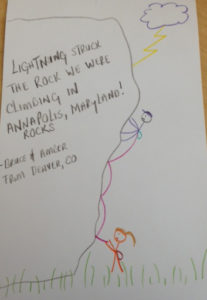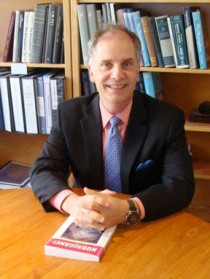
A new exhibit exploring the power of weather and the stories behind it opened earlier this month at NCAR’s Mesa Lab in Boulder, Colorado. Spark, the group that oversees science education at UCAR, created the exhibit with input from scientists, engineers, designers, and writers.
“Weather is a fascinating topic and it affects us all,” comments Rajul Pandya, director of Spark. “In the new Weather Gallery, visitors can touch clouds, make forecasts, and learn how scientists understand weather using special instruments and computer simulations.”
The NCAR Weather Gallery joins existing exhibits like an eight-foot-tall tornado, a microburst generation tank, and a display that shows current wind speeds measured on top of the building. One of the new features is the interactive, “Tell Your Weather Story,” which gives visitors the opportunity to describe and post their own experiences on weather.
It took about 20 months to plan and develop the exhibit from start to finish. To begin the process, an advisory committee met to decide what topics the exhibit should cover and what they wanted visitors to experience. They came up with a plan that included five content sections and several different ways of delivering information, which included hands-on interactives, large mural photos, panels with pictures and text, and touch screens with games and videos.
Since the exhibit opened on 10 October, the Mesa Lab has had approximately 2,000 visitors, with at least half that number spending time in the exhibits. About 15,000 people a year attend scheduled programs at lab, including 10,000 K-12 students and teachers who take classes and go on tours, as well as 5,000 in special groups and public tours.
“People are really excited about the new exhibit. Visitors love all of the opportunities to play with the hands-on stuff, and it’s been fun to see groups of visitors interacting with each other as they explore different parts of the exhibit,” says Becca Hatheway, NCAR exhibit manager. “UCAR and NCAR staff members are also excited to see something new in this space. I’ve seen just as many staff spending time in the exhibits as I have seen visitors. So I guess we’re all excited to learn more about the weather.” The visitor center at the Mesa Lab is open to the public year round and offers free exhibits about weather and climate, a gallery featuring local artists, an outdoor weather trails, and more. For more information visit the Spark web site.
And speaking of Spark, today (Saturday, 27 October) is UCAR’s Super Science Saturday from 10 a.m. to 4 p.m.–a chance for the whole family to visit the labs and combine science with some Halloween fun. There’s a preview video at the Spark home page:
UCAR
UCAR's Next President, Thomas Bogdan

The University Corporation for Atmospheric Research (UCAR) announced today that Thomas Bogdan will succeed Richard Anthes as its next president, beginning in January 2012.
Bogdan has been director of the National Oceanic and Atmospheric Administration’s Space Environment Center in Boulder, Colorado, since 2006. A Fellow of the AMS and current member of our Council, Bogdan moved to NOAA after a long stint at UCAR’s National Center for Atmospheric Research, beginning as a post-doc, moving up through the Scientist and administrative ranks, and eventually serving as Acting Director of NCAR’s Advanced Studies Program. From 2001-2003 Bogdan was Program Director for the National Science Foundation’s Solar-Terrestrial Research Section. He received his Ph.D. in physics at the University of Chicago in 1984.
You can hear a recent interview with Bogdan about space weather on Colorado Public Radio.
Or watch his presentation about space weather from 2007 at the Commercial Space Transportation Conference: